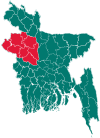Godagari Upazila
 From Wikipedia the free encyclopedia
From Wikipedia the free encyclopedia
Godagari গোদাগাড়ী | |
|---|---|
 | |
| Coordinates: 24°28′N 88°19.8′E / 24.467°N 88.3300°E | |
| Country | |
| Division | Rajshahi |
| District | Rajshahi |
| Area | |
| • Total | 475.26 km2 (183.50 sq mi) |
| Population (2011) | |
| • Total | 330,924 |
| • Density | 700/km2 (1,800/sq mi) |
| Time zone | UTC+6 (BST) |
| Website | Official Map of Godagari |
Godagari (Bengali: গোদাগাড়ী) is an Upazila of Rajshahi District in the Division of Rajshahi, Bangladesh.[1] This is the place where Mahananda river fall to Padma or Ganges.
History[edit]
The Deopara Prashasti, an important inscription in Sanskrit poetry describing the Sena dynasty of ancient Bengal, was discovered near the village of Deopara.[2]
Geography[edit]
Godagari is located at 24°28′00″N 88°19′50″E / 24.4667°N 88.3306°E. It has 72,186 households and total area 475.26 km2.
Godagari Upazila is bounded by Chapai Nawabganj Sadar Upazila of Chapai Nawabganj district and Tanore Upazila on the north, Tanore and Paba Upazilas on the east, Lalgola, Bhagawangola I and Bhagawangola II CD Blocks, in Murshidabad district, West Bengal, India, all across the Ganges/ Padma, on the south, and Chapai Nawabganj Sadar Upazila on the west.[3][4]
Demographics[edit]
According to the 2011 Bangladesh census, Godagari Upazila had 72,186 households and a population of 330,924. 75,724 (22.88%) were under 10 years of age. Godagari had a literacy rate (age 7 and over) of 46.34%, compared to the national average of 51.8%, and a sex ratio of 990 females per 1000 males. 61,176 (18.49%) lived in urban areas.[5] Ethnic population was 24,438 (7.38%), of which Santal were 11,440 and Oraon 6,752.[6]
As of the 1991 Bangladesh census, Godagari has a population of 217,811. Males constitute 50.88% of the population, and females 49.12%. This Upazila's eighteen up population is 108869. Godagari has an average literacy rate of 27.6% (7+ years), and the national average of 32.4% literate.[7]
Points of interest[edit]
Padumsa Dighi (pond) of Raja Bijoy Sen at village Deopara (eleventh century), tomb of Shah Sultan at Sultanganj (fourteenth century), tomb of Ali Kuli Beg at Kumarpur,
Marks of War of Liberation Memorial monument 1 (Sheikherpara).
Administration[edit]
Godagari thana was established in 1865 and was turned into an upazila in 1984.
Godagari Upazila is divided into Godagari Municipality, Kakanhat Municipality, and nine union parishads: Basudebpur, Char Ashariadaha, Deopara, Godagari, Gogram, Matikata, Mohanpur, Pakri, and Rishikul. The union parishads are subdivided into 389 mauzas and 398 villages.[5]
Education[edit]
According to Banglapedia, Godagari School & College, founded in 1905, is a notable secondary school.[1]
References[edit]
- ^ a b Kaisaruzzaman, AKM (2012). "Godagari Upazila". In Islam, Sirajul; Jamal, Ahmed A. (eds.). Banglapedia: National Encyclopedia of Bangladesh (Second ed.). Asiatic Society of Bangladesh.
- ^ Aksadul Alam (2012), "Deopara Prashasti", in Sirajul Islam and Ahmed A. Jamal (ed.), Banglapedia: National Encyclopedia of Bangladesh (Second ed.), Asiatic Society of Bangladesh
- ^ "Godagari Upazila". Banglapedia. Retrieved 15 November 2018.
- ^ "Tehsil Map of Murshidabad". CD Block/ Tehsil. Maps of India. Retrieved 15 November 2018.
- ^ a b c "Bangladesh Population and Housing Census 2011 Zila Report – Rajshahi" (PDF). bbs.gov.bd. Bangladesh Bureau of Statistics.
- ^ "Community Tables: Rajshahi district" (PDF). bbs.gov.bd. Bangladesh Bureau of Statistics. 2011.
- ^ "Population Census Wing, BBS". Archived from the original on 2005-03-27. Retrieved November 10, 2006.
